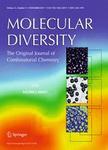版权所有:内蒙古大学图书馆 技术提供:维普资讯• 智图
内蒙古自治区呼和浩特市赛罕区大学西街235号 邮编: 010021

作者机构:Guangdong Med Univ Dongguan Affiliated Hosp 1 Dongguan Key Lab Comp Aided Drug Design Dongguan 523710 Peoples R China Guangdong Med Univ Key Lab Big Data Min & Precis Drug Design Sch Pharm Guangdong Prov Key Lab Res & Dev Nat Drugs Dongguan 523808 Peoples R China Beijing Univ Chem Technol State Key Labs Chem Resources Engn Beijing 100029 Peoples R China
出 版 物:《MOLECULAR DIVERSITY》 (Mol. Diversity)
年 卷 期:2025年
页 面:1-21页
核心收录:
学科分类:0710[理学-生物学] 1007[医学-药学(可授医学、理学学位)] 07[理学] 070203[理学-原子与分子物理] 0703[理学-化学] 0702[理学-物理学]
基 金:Guangdong Medical University [3007/2BH24009]
主 题:Breast cancer PARP-1 ML-based screening Molecular docking simulation DFT analysis
摘 要:Cancer remains one of the leading causes of death worldwide, with the rising incidence of breast cancer being a significant public health concern. Poly (ADP-ribose) polymerase-1 (PARP-1) has emerged as a promising therapeutic target for breast cancer treatment due to its crucial role in DNA repair. This study aimed to discover novel, targeted, and non-toxic PARP-1 inhibitors using an integrated approach that combines machine learning-based screening, molecular docking simulations, and quantum mechanical calculations. We trained a widely used machine learning models, Random Forest, using bioactivity data from known PARP-1 inhibitors. After evaluating the performance, it was used to screen an FDA-approved drug library, successfully identifying Atazanavir, Brexpiprazole, Raltegravir, and Nisoldipine as potential PARP-1 inhibitors. These compounds were further validated through molecular docking and all-atom molecular dynamics simulations, highlighting their potential for breast cancer therapy. The binding free energies indicated that Atazanavir at - 41.86 kJ/mol and Brexpiprazole at - 45.44 kJ/mol exhibited superior binding affinity compared to the control drug at - 30.42 kJ/mol, highlighting their promise as candidates for breast cancer therapy. Subsequent optimized geometries and electron density mappings of the two molecular structures revealed a Gibbs free energy of - 2334.610 Ha for the first molecule and - 1682.278316 Ha for the second, confirming enhanced stability compared to the standard drug. This study not only highlights the efficacy of machine learning in drug discovery but also underscores the importance of quantum mechanics in validating molecular stability, setting a robust foundation for future pharmacological explorations. Additionally, this approach could revolutionize the drug repurposing process by significantly reducing the time and cost associated with traditional drug development methods. Our results establish a promising basis for subsequent re